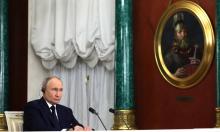Russia and China spend billions on lunar exploration
Russian governmental delegation headed by Vice Prime Minister Alexander Zhukov has arrived in China. The preparations for a state visit to China by Russian Prime Minister Mikhail Fradkov are under way. Fradkov’s visit should commence later this week. According to information obtained by Izvestia, Russia and China agreed on a large-scale joint effort in Moon exploration project. The plans are expected to be formally confirmed during Fradkov’s upcoming visit to China. Russia, the United States and China are still the only three nations capable of launching a manned spacecraft independently. China has spent about $4 billion on its space program since the early 1990s though it has only two taikonauts. Russia remains the only country with which China maintains cooperation in the field of space exploration.

Read more on Pravda.ru: Will humans ever conquer the Moon?
In September 2006, Russia and China adopted a joint space exploration program for 2007-2009. The program comprises 38 projects. Now the two countries intend to focus on a joint lunar exploration project. U.S. President George W. Bush earlier unveiled America’s ambitious space program aimed at lunar colonization. However, neither Russia nor China is included in the U.S. lunar exploration program.
Russia seems to be the only country with which China maintains cooperation in the field of space exploration. Having opted for an independent space exploration program, China refused to take part in the International Space Station Project. Consequently, China announced its intention to build its own space station. The Chinese admit that the space program of the People’s Republic of China began in the 1950s with the participation of the USSR. Trainers and space instructors for the National Space Training Center were trained at Star City in Russia in the 1990s. Wang Xingqing, general designer with the Chinese Piloted Space Programs, was educated in Moscow Aviation Institute. The design of the Shenzhou spaceship (meaning “Magic Vessel” in Chinese) is based on Russian technology. The Long March rocket resembles the Russian UR-200 designed by Chelomei. China purchased a mockup of the Russian Soyuz TM, docking equipment and life support systems. Meanwhile, China stresses the point that all the design features including those of a space watch for taikonauts are original.
Two years ago China formally started the implementation phase of its unmanned Moon exploration project. According to the China National Space Administration, an unmanned space vehicle should be launched to the moon before 2010. China also announced its plans to deep space exploration focusing on March. Experts were quick to express doubts about the feasibility of the above projects, which China intended to carry out on its own. However, the job can be done once China ’s financial potential is coupled with the Russian technological capabilities including the Klipper Spacecraft Project and a series of reliable heavy-weight launch vehicles, not to mention a lunar lander developed for a Soviet manned mission to the Moon that was canceled in the 1970s.
The U.S. and Russia had been in absolute control over space until China started a new page in history of space exploration by launching a human into space in October 2003. By comparison to the U.S. and Russia, China had a smaller number of unmanned space test fights prior to conducting its first manned mission, which made China the world’s third space nation.
As regards long-term changes in space exploration, it is far too early to make any predictions until Russia and China start working in tandem.
Izvestia Nauki
Translated by Guerman Grachev
Pravda.ru
Subscribe to Pravda.Ru Telegram channel, Facebook, RSS!





